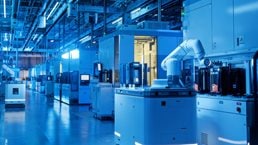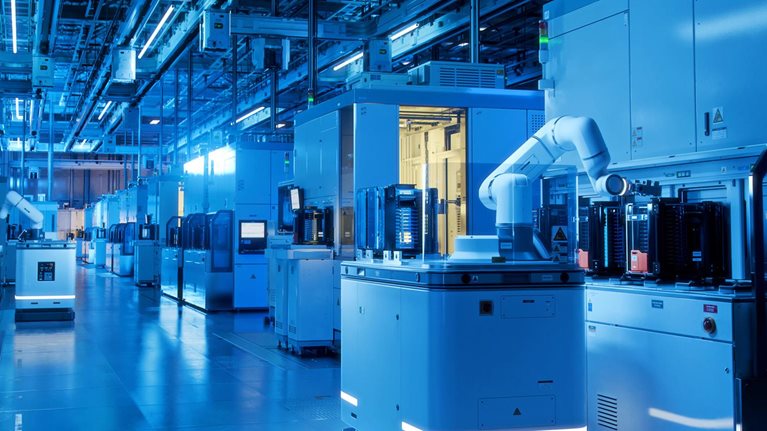By now, it’s old news: semiconductor demand is growing. What’s new, however, is how several global trends—including the rise of artificial intelligence, vehicle electrification, and autonomous driving—will broaden demand and take it to even greater heights over the next decade.
Already, many incumbents and new entrants in semiconductor manufacturing are expanding their operations to capture the increasing opportunities along the entire value chain, including those related to wafer manufacturing, chemical supply, packaging, capital equipment, and other areas. Globally, companies plan to invest about $1 trillion in semiconductor fabs through 2030. Most investment is concentrated in Asia and the United States, but funding for European projects is also increasing.
For some semiconductor companies, expansion efforts may involve building fabs in regions or countries where they have not previously operated. In the past, companies that explored such opportunities sought locations with established semiconductor ecosystems that met some basic requirements: sufficient and stable energy and water supplies, a pool of potential employees with technical skills, the right infrastructure, and a solid transportation network. Well-known ecosystems that fall into this category include Taiwan’s Hsinchu Science Park and Germany’s Silicon Saxony. (For more information on these locations, see sidebar, “Thriving semiconductor ecosystems.”)
When semiconductor companies consider expansion today, they still restrict their search to locations that meet their basic requirements. But simply meeting these requirements is not enough to guarantee investment. Instead, semiconductor companies now focus on three S’s—sustainability, supply chain security, and subsidies—as they select new sites. Their shifting priorities reflect changes occurring in the world at large, including growing concern about climate change, geopolitical issues that are disrupting or slowing shipments, and economic uncertainty.
Given the value of the semiconductor industry, as well as its benefits to local economies, much is at stake as companies expand, both for the businesses themselves and for the regions or countries where they establish new sites. Here’s a look at the industry’s growth potential and the factors that may determine where new fabs are built over the next decade.
Would you like to learn more about our Semiconductors Practice?
Would you like to learn more about our Semiconductors Practice?
A thriving market that encourages expansion
The global market for semiconductors is projected to reach $1 trillion by 2030, up from $600 billion in 2021 (Exhibit 1). Although the wireless communication and computing sectors are currently undergoing some disruptions, such as lower demand for mobile phones in certain countries, they are expected to experience the strongest long-term growth, followed by the automotive and industrial sectors.

No single country or region dominates any segment of the supply chain, with the notable exception of Asia and its strong manufacturing hubs (Exhibit 2). What’s more, no region or country has strong capabilities in every segment of the value chain, so the end-to-end process for creating a semiconductor involves a global effort. A plant in Japan might cut silicon ingots into wafers, which are then shipped to the United States for fabrication into semiconductors. The next leg of the process could take them to Malaysia for sorting, cutting into dies, assembly, packaging, and testing. Finally, they might be sent to Singapore for incorporation into a finished product as a chip.

The dispersion of expertise gave semiconductor companies some freedom during past expansion efforts, since they could typically find multiple ecosystems that met their needs. Although they traditionally gravitated to areas with large, established semiconductor ecosystems, a few bucked the trend by venturing into new regions, as California-based Intel did in Oregon in 1974, Arizona in 1980, and Ireland in 1989. These moves conferred various advantages, such as lower utility prices and, in the case of Oregon, greater land availability.
Today, many semiconductor companies still focus on locations with large ecosystems—new fabs are now being built in Dresden, which is at the center of the Silicon Saxony semiconductor hub, for example—but there’s a growing trend toward considering other countries or regions because they score high for sustainability, supply chain security, and subsidies. Here again, the global dispersion of expertise could be an advantage. Since no region or country dominates any step of the value chain, with the exception of Asia’s pure-play foundries, companies will not be competing against a single ecosystem that dominates the industry.
To see how investment is shifting to new regions and countries, consider what’s now occurring in the United States. While the country saw little fab construction over the past few decades, the value of US-based semiconductor projects that are now under way, announced, or under consideration is estimated to range from $223 billion to over $260 billion through 2030.1 Companies are also more likely to investigate opportunities in US states that have not traditionally attracted the greatest semiconductor investment, with Intel building facilities in Ohio and Skywater planning to expand in Indiana.
New prerequisites and investment calculations
What’s behind the shift that is prompting semiconductor companies to focus on the three S’s, and what do they stand to gain? And what do these trends mean for regions and countries that want to attract more semiconductor investment? To answer these questions, we examined recent developments related to supply chains, sustainability, and subsidies.
A secure location that minimizes supply chain risks
With the recent pandemic, global economic uncertainty, and the war in Ukraine, executives’ risk perceptions are rapidly shifting. According to a recent McKinsey survey of CEOs in advanced industries, many executives now view geopolitical dynamics as the most important challenge to their businesses.2 In response, many leaders are now actively monitoring supply chain risks and developing strategies to prevent disruptions. One strategy that is now receiving much attention involves localizing semiconductor manufacturing to prevent disruptions and increase resilience.
Governments often welcome nearshoring efforts because they want to ensure a steady chip supply for local companies, including automakers and other businesses that depend on semiconductors. They also realize that access to chips is essential for many government security platforms.
Sustainability and decarbonization as a clear priority
Motivated by both voluntary and mandatory targets, all semiconductor companies are attempting to reduce their emissions. These efforts may help them meet emerging regulatory guidelines and satisfy the needs of their most important end customers. Many of these companies have set ambitious emissions reduction targets. Microsoft, for instance, wants to be carbon negative by 2030. To meet these goals, end customers must not only mitigate or eliminate their own emissions but they must also address Scope 3 upstream emissions, which include those that arise from the suppliers that provide them with products or components.3 If semiconductor companies do not take proactive steps to reduce emissions, their customers might instead purchase carbon offsets—and they might attempt to pass the associated costs to suppliers in the form of price reductions or margin erosion.
Some semiconductor companies have already set emissions reduction goals, and their strategies often involve transitioning to renewable sources because greater than one-third of a typical fab’s emissions arise from energy usage. Intel, which wants to reach net-zero greenhouse gas emissions by 2040, hopes to achieve 100 percent use of renewable electricity by 2030. The ability to shift to renewable energy will differ by location. While Singapore has a thriving semiconductor ecosystem, for instance, little land is available for building renewable-energy systems. Other locations face challenges because regulatory frameworks are still nascent.
If semiconductor companies in the United States or other countries with relatively high production costs can rely entirely on renewable sources, their energy costs could be two to four times lower than those in many Asian countries. This decrease might help offset some of their other expenses. Eventually, fabs in locations with little renewable energy might purchase it from other countries, which could raise overall energy costs above current rates. Singapore, for instance, wants to import 4 gigawatts of low-carbon electricity—equivalent to about 30 percent of its electricity supply—from neighboring countries by 2035.4

Semiconductor fabs: Construction challenges in the United States
Subsidies
The European Union and the United States have increased the subsidies offered to semiconductor companies over the past few years. In another big shift, some countries without strong semiconductor ecosystems are actively trying to encourage the growth of such ecosystems within their borders. India and Spain are among the countries that have announced new programs over the past 12 to 18 months; these programs are designed to attract semiconductor investment and could have a major impact on site selection for new fabs.
The subsidies offered today are often higher than they were in the past and may include new incentives. For instance, subsidies in the United States have historically involved state and local programs, such as property or sales tax abatements, but policy shifts have expanded the potential benefits. Consider some recent government-sponsored efforts to reshore high-tech manufacturing:
- United States. Currently, the United States only manufactures about 12 percent of the world’s chips, and none are the most advanced varieties. The CHIPS and Science Act allocates over $50 billion for direct funding, federal loans, and loan guarantees designed to expand American semiconductor research and manufacturing. If successful, it would reduce dependence on foreign suppliers.
- European Union. Member countries have agreed to provide $47 billion in public funding aimed at doubling the European Union’s share of global chip output to 20 percent by 2030.
- Japan. This country only has a 10 percent share of the global semiconductor market, down from about 50 percent in the 1980s. The Japanese government has announced $6.8 billion in public investment to expand domestic semiconductor production.
The increased subsidies have important implications because expansion is so costly. (The average cost of constructing and equipping a new fab is approaching $10 billion and could exceed that in some cases.) A recent McKinsey analysis reveals that subsidy levels have a greater impact than location on reducing the payback period for fab investments (Exhibit 3). For instance, a subsidy equal to 45 percent of the required investment will reduce the payback period to 6.5 years, compared with 10.0 years for unsubsidized facilities.

One downside to increased subsidies: they are raising the cost of entry for regions that want to attract investment from semiconductor companies, and the hurdles could become even higher if they continue to rise. Regions that have historically had a significant semiconductor presence could be at the greatest disadvantage.
The power of strong, local ecosystems
Semiconductor companies are not the only group that stands to gain from greenfield expansion, especially if it helps countries create ecosystems similar to Hsinchu Science Park. Such developments can offer broad rewards for regional economies, because semiconductors enable growth in a variety of realms. For example, they are essential to the growth of the Internet of Things, which is expected to have a global market worth of $4.4 trillion by 2030, and the robotics market, which is expected to be valued at $120.0 billion. If a region or country has many technology companies , a strong local supply of semiconductors could help them thrive, resulting in more jobs and a stronger regional economy.
Economic data clearly show the benefits of nurturing the semiconductor industry. It is the second-most-profitable industry in the world and thus has a major impact on GDP.5 It also accounts for the second-highest amount of R&D spending, thus contributing to the creation of many highly skilled jobs.6 Finally, the semiconductor industry also has strong economic multipliers, with investments estimated to increase its current value to GDP by threefold within six years. Employment multipliers are also strong, with every new job within the semiconductor industry expected to sustain over five new jobs in other industries.
Governments and companies could foster ecosystem development if they consider working together and establishing joint goals. But such “competitive cooperation,” as some semiconductor companies’ executives call it, is challenging in the best of times and even more so in these uncertain days, where agendas, goals, and long-term plans can be subject to change. Can these actors collaborate on developing an agenda and shared goals? Can appropriate governance controls be installed to resolve potential conflicts and remain in compliance with all local laws? Are sufficient supply chain protections and skilled labor available and willing to be deployed together? What mutual efforts are needed to build a capable workforce and ensure that the necessary infrastructure is available?
These are hard questions. Nevertheless, committed companies and countries that successfully address them may foster the development of major semiconductor ecosystems that deliver returns that would far exceed those associated with a single new semiconductor company. In other words, the resulting juice may justify the squeeze of the additional effort.
Within the semiconductor industry, the macroeconomic sands are shifting. The demand outlook is exciting, geopolitical dynamics are changing, decarbonization is increasingly at the forefront, and countries are offering unprecedented incentives for greenfield investment. The emerging opportunities will help both incumbents and new companies that want to enter the fray. In all cases, subsidies, sustainability, and supply chain security will be among the most important considerations when selecting a location for greenfield building or expansion. If companies, governments, and other stakeholders successfully cooperate to create new semiconductor ecosystems, the advantages will extend far beyond individual countries or businesses. The entire industry—and the world as a whole—could benefit from the innovations that emerge.


